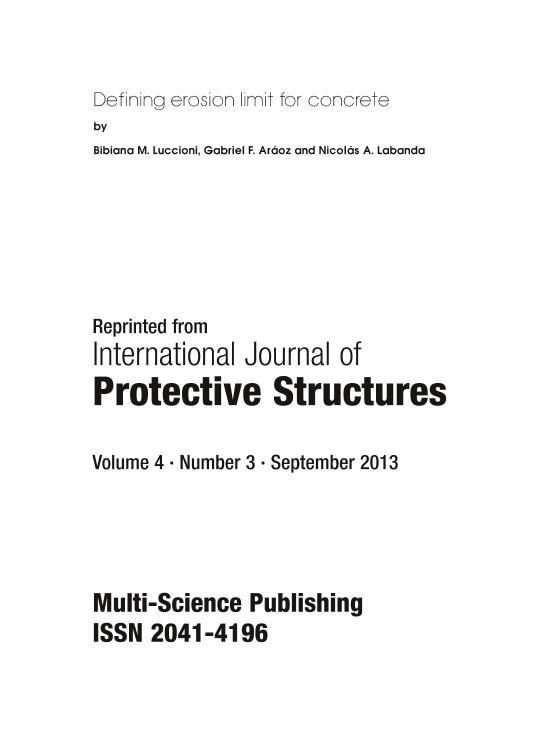Mostrar el registro sencillo del ítem
dc.contributor.author
Luccioni, Bibiana Maria

dc.contributor.author
Araoz, Gabriel Francisco

dc.contributor.author
Labanda, Nicolás Agustín

dc.date.available
2016-08-25T19:16:17Z
dc.date.issued
2013-09
dc.identifier.citation
Luccioni, Bibiana Maria; Araoz, Gabriel Francisco; Labanda, Nicolás Agustín; Defining Erosion Limit for Concrete; Multi-Science Publishing; International journal of Protective Structures; 4; 3; 9-2013; 315-340
dc.identifier.issn
2041-4196
dc.identifier.uri
http://hdl.handle.net/11336/7303
dc.description.abstract
Numerical simulation is usually used for predicting the response of concrete and fiber reinforced concrete structures to blast or impact loads. Depending on both charge weight and standoff distance, blast loads can cause fracture and spalling of concrete. In order to numerically reproduce these effects, an erosion model can be used to remove from the calculation the elements that have reached certain criteria. This erosion model represents a numerical tool to avoid great distortion of Lagrange meshes. For this reason, its application to the simulation of a physical phenomenon requires the calibration with experimental results. A review of different erosion criteria and limits used by different authors to simulate concrete under blast loads is presented in this paper. Some application examples and comparisons with experimental results are developed to show the effect of erosion limit on damage results and the dependence on the materials properties, mesh size and scaled distance.
dc.format
application/pdf
dc.language.iso
eng
dc.publisher
Multi-Science Publishing
dc.rights
info:eu-repo/semantics/openAccess
dc.rights.uri
https://creativecommons.org/licenses/by-nc-sa/2.5/ar/
dc.subject
Blast
dc.subject
Concrete
dc.subject
Erosion
dc.subject
Numerical Simulation
dc.subject.classification
Ingeniería de los Materiales

dc.subject.classification
Ingeniería de los Materiales

dc.subject.classification
INGENIERÍAS Y TECNOLOGÍAS

dc.subject.classification
Ingeniería Estructural

dc.subject.classification
Ingeniería Civil

dc.subject.classification
INGENIERÍAS Y TECNOLOGÍAS

dc.title
Defining Erosion Limit for Concrete
dc.type
info:eu-repo/semantics/article
dc.type
info:ar-repo/semantics/artículo
dc.type
info:eu-repo/semantics/publishedVersion
dc.date.updated
2016-08-11T19:35:59Z
dc.journal.volume
4
dc.journal.number
3
dc.journal.pagination
315-340
dc.journal.pais
Reino Unido

dc.journal.ciudad
Los Angeles
dc.description.fil
Fil: Luccioni, Bibiana Maria. Universidad Nacional de Tucuman. Facultad de Ciencias Exactas y Tecnologia. Instituto de Estructuras "Ing. Arturo M. Guzman"; Argentina. Consejo Nacional de Investigaciones Científicas y Técnicas. Centro Científico Tecnológico Tucumán; Argentina
dc.description.fil
Fil: Araoz, Gabriel Francisco. Universidad Nacional de Tucuman. Facultad de Ciencias Exactas y Tecnologia. Instituto de Estructuras "Ing. Arturo M. Guzman"; Argentina
dc.description.fil
Fil: Labanda, Nicolás Agustín. Universidad Nacional de Tucuman. Facultad de Ciencias Exactas y Tecnologia. Instituto de Estructuras "Ing. Arturo M. Guzman"; Argentina. Consejo Nacional de Investigaciones Científicas y Técnicas. Centro Científico Tecnológico Tucumán; Argentina
dc.journal.title
International journal of Protective Structures
dc.relation.alternativeid
info:eu-repo/semantics/altIdentifier/url/http://prs.sagepub.com/content/4/3/315.abstract
dc.relation.alternativeid
info:eu-repo/semantics/altIdentifier/doi/http://dx.doi.org/10.1260/2041-4196.4.3.315
Archivos asociados
